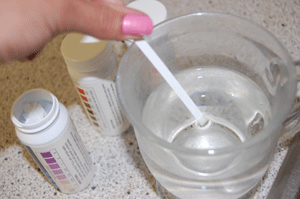Rural residents often wonder what’s in their drinking water or if their water is safe.
All water from natural sources contains dissolved substances. The substances in water can result from either natural processes or human activities. At low concentrations, many do not cause known harmful effects and may be beneficial. Research shows some substances may be harmful when present at high enough concentrations.
The only way to know if the water you use for drinking and cooking contains potentially harmful substances at levels high enough to be of concern is to have the water tested. Analytical testing can determine what substances are present and their concentration levels.
Testing a private water supply in Nebraska is not required by federal or state regulations. Regulatory exceptions occur where state licensing may be required for a specific activity. Local regulations may be more stringent than those issued by the state.
There is no single test to determine the safety of drinking water. Many substances can present a health risk if present in sufficient concentrations. These include biological contaminants such as bacteria or viruses; inorganic chemicals such as lead or nitrate; and organic chemicals such as insecticides, herbicides, fuel and solvents. Other substances, while not a health risk, can make water less desirable for domestic use. These are referred to as nuisance contaminants and include calcium, magnesium, iron, manganese and hydrogen sulfide. It would be costly, and in most cases unnecessary, to test private water supplies for the nearly 100 contaminants for which public water supplies are required to test.
Users of private drinking water wells must decide which contaminants to test for and must order tests accordingly. A water testing laboratory only tests for specifically requested contaminant analysis. Reports will indicate if the contaminant is present in the water and at what concentration. Information will not be provided on contaminants for which analysis was not specifically requested.
Generally, private water supplies should be tested annually for bacteria and nitrate contamination. Coliform bacteria is most likely to be found during periods of wet weather when the soil is warm. Runoff and excess soil moisture carry contaminants into shallow groundwater sources or through well defects. To assess the year-round safety of drinking water, test for bacteria in the late spring or early summer during wet weather. The best location to collect a water sample is at the tap used most frequently for drinking and cooking. Take care when sampling for bacterial contaminants. Do not touch the inside of the bottle or lid when taking the sample. Most laboratories recommend removing the aerator from an interior faucet before collecting a bacteria water sample, and some recommend disinfecting the faucet with heat or chlorine before collection. Follow directions carefully or solicit the services of a professional.
Testing for bacteria and nitrate does not guarantee the water is safe, as other contaminants could be present. Aquifers, which supply groundwater, are vulnerable to many types of contamination.
Contaminants can enter aquifers and groundwater from septic systems, landfills, fertilizer and pesticide use, sewage, animal waste, fuel storage tanks, and many other sources. Even distant contamination can negatively impact a water supply given time, as groundwater moves slowly. In addition, some contaminants are introduced to groundwater from naturally occurring sources such as the rock and minerals that make up the aquifer. Test for substances when specific contamination is suspected. This might be the result of a spill, backflow, use of product in close proximity to the well or other such event. If any contaminant is detected in a nearby private or public well, private water users in close proximity should consider testing their water supply for the contaminant. The information below may be helpful in determining what analysis to request for private drinking water.
Many Nebraska laboratories offer testing services including water analyses. The Nebraska Department of Health and Human Services approves laboratories to test drinking water samples. Not all laboratories are approved to test for all drinking water contaminants. Rather, approval must be obtained for each specific contaminant. To receive approval for a contaminant, a laboratory must use approved testing methods and equipment. Approval provides some assurance that the laboratory has the capability to perform water quality analysis within an acceptable range of accuracy and will provide reliable results. It does not guarantee a specific water sample analysis has been or will be performed accurately. Non-approved laboratories may use the same equipment and procedures as approved laboratories and may provide accurate analysis, but there is no independent information about the laboratory’s ability to obtain reliable results.
The Nebraska Department of Health and Human Services can provide information on request regarding all laboratories located and approved in Nebraska, and can provide information on the specific contaminants for which each is approved. They can be reached at 402 471-8407.
The quality and safety of water provided by private wells in Nebraska is not regulated by federal or state statutes. Water test results provide valuable information. Results can be compared to the guidelines for public drinking water supplies, and informed decisions can be made.
Summary of home water quality problems and possible source or cause (not a complete list)
Hard Water, Staining, Deposits, Degradation of Household Plumbing
| Symptom | Possible source to Test for |
|---|---|
| White scaly deposits in pipes or appliances; soap scum in sinks and bathtubs | Calcium and magnesium (water hardness) |
| Green stains on fixtures, blue-green tint to water | Copper |
| Reddish-brown stains on sinks, porcelain fixtures, or laundry | Iron |
| Brownish-blackish stains on fixtures and laundry; affects the flavor and color of food and water | Manganese Iron bacteria |
| Reddish-brown slime Brownish-black slime | Manganese bacteria |
Taste
| Symptom | Possible source to Test for |
|---|---|
| Soda taste, slippery feel | Total dissolved solids that are alkaline |
| Salty or brackish water; blackening and pitting of stainless steel sinks and kitchen utensils | Total dissolved solids, chloride, sodium, sulfate |
| 5,280 ft wire | $107.96 |
Odors
| Symptom | Possible source to Test for |
|---|---|
| ‡ Gasoline or oil smell | Volatile organic chemicals |
| Rotten egg odor | Dissolved hydrogen sulfide (difficult to test for), sulfate- reducing bacteria |
| ‡ Septic, musty or earthy | Coliform bacteria, iron bacteria, manganese bacteria, sulfur bacteria |
Appearance
| Symptom | Possible source to Test for |
|---|---|
| Water appears clear when first drawn; turns reddish-brown during cooking/heating, or water is discolored when drawn | Iron |
Other
| Symptom | Possible source to Test for |
|---|---|
| ‡ Arsenic suspected or detected in the aquifer | Arsenic |
| ‡ Uranium suspected or detected in the aquifer | Uranium |
| ‡ High fluoride suspected or detected in the aquifer | Flouride |
| ‡ Heavy fertilization in close proximity to the water source or well | Nitrate |
| ‡ Animal manure in close proximity to the water source or well | Nitrate and bacteria |
| ‡ Use, storage, or mixing of herbicide, insecticide, rodenticide, or fungicide in close proximity to the water source or well | Herbicide, insecticide, rodenticide, or fungicide identified |
| ‡ Dry-cleaning operation, private dump, junkyard, landfill, manufacturing facility, or gas station in close proximity to the water source or well | Volatile organic chemicals and heavy metals |
| ‡ Possible incomplete sewage treatment due to failing septic system in close proximity to the water source or well | Nitrate and bacteria |
| ‡ Contaminant detected in nearby private or public well | Contaminant identified |
| ‡ Household contains lead or brass plumbing | Lead |
| ‡ Recurring gastrointestinal illness of residents, or gastrointestinal illness of visitors | Coliform bacteria |
‡ If water testing for these chemicals returns a positive reading for public water supplies, additional action should be pursued to assure a safe private drinking water supply. Actions to consider may include obtaining an alternate water supply, connecting to a public or rural water supply, using appropriate treatment to remove or reduce the contaminant, using bottled water for cooking and drinking, or other options. Each situation should be thoroughly investigated and informed decisions should be made.

